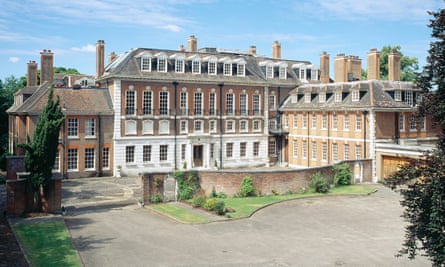The leafy suburb of Highgate in north London has long enjoyed a liberal, even radical, reputation. Its high concentration of left-leaning creative professionals was drawn to the area not just by large green spaces and fine views, but also by the legacy of wealthy social reformers who led campaigns from the salons of their grand mansions.
But those same properties are at the centre of a growing battle between middle-class pillars of the community and a new generation of super-rich residents. The Highgate Society says it is launching at least one appeal per month against planning applications for mega-mansions, huge extensions and iceberg basements.
“It’s much more than extensions,” said architect Elspeth Clements, chairwoman of the society’s planning group. “It’s wholesale demolition of fine houses, generally of the arts and crafts period, and their replacement with something neoclassical and alien to the character of the area. One particularly poor example was a replica of what looked like Buckingham Palace squeezed on to a narrow site.”
The cause of the conflict between the Highgate elite and the recent influx of the global super-wealthy is their disparate reasons for living in the area, according to a new study of Highgate that is part of a two-year investigation into the social impact of the super-rich on London, entitled Life in the Alpha Territory.
The researchers from Goldsmiths, University of London and King’s College London found that, while Highgate’s old elite took civic pride in its environment and architectural heritage, the uber-wealthy were not interested in the area’s cachet or the period features of the local architecture. Their primary concern was to find a home of at least 6,000 sq ft, or one that could be remodelled to at least that size. Period features were ripped out in “often brutal structural conversions of older properties into state-of-the-art living spaces” and replaced with luxury brand fixtures and fittings and an inoffensive minimalist aesthetic. For those who cannot afford detached mansions, that can mean excavating huge basements under terraced or semi-detached town houses.
This trend is evident in the portfolios of local estate agents. On sale at Savills’s Highgate branch is a £10.75m house on Courtenay Avenue, one of two private roads with security barriers in the neighbourhood. The price of the 5,395 sq ft property includes planning permission “for a magnificent new residence of 13,488 sq ft over four floors behind a retained facade” to include a leisure complex with pool and cinema.

Professor Richard Webber, of King’s College London, co-author of the study, said the new breed of billionaire or multimillionaire was either foreign or worked abroad and treated their home as just another asset in an investment portfolio. Many of them did not share the values of local people, so restrictions such as conservation regulations were regarded as an onerous and unreasonable burden on their personal freedom and opportunity for financial gain.
“The top tier live in detached £20m-£30m homes with off-street parking for several cars,” said Webber, who has lived in the area for 25 years. “They have electronic gates and garages attached to the house for security reasons. If they go out, they don’t use the [local] shops. They won’t stop between where they live and Mayfair.”
The study found that the escalation of house prices in Highgate had led to “younger, high-achieving professionals enjoying a cosmopolitan lifestyle in a gentrified urban environment”, with academics, journalists, architects and public sector workers being displaced by the global super-rich and the “very top echelons of the middle classes that service it”, such as bankers, lawyers and financiers.
Michael Hammerson, a vice-president of the Highgate Society, said: “Highgate has always been a resort for the super-rich. But in the past the owners recognised that they were part of the local community. They had a sense of noblesse oblige. Now this is all lost. They want to be fenced off.”
The clash in values between the more traditional residents of the area and the new super-rich has been played out in planning disputes. Among the most notorious local redevelopments is the massive makeover of Witanhurst, an imposing Grade II-listed Queen Anne-style mansion. In the 19th century, its then owner Sir Arthur Crosfield led the campaign to preserve Hampstead Heath from redevelopment. Today its grounds are lined with portable buildings, metal containers and scaffolding. A 40,000 sq ft, two-storey basement has been excavated to house a cinema, sauna and swimming pool. The property, bought by the family of the Russian billionaire Andrei Guriev in 2008, will be the second-largest private home in London after Buckingham Palace when completed and will have an estimated value of £300m.

But such mega-mansions were the tip of the iceberg, according to Clements. She said the problem had spread from homes in The Bishops Avenue, nicknamed “billionaire’s row”, into other relatively less prime streets. “The area between the village and Archway Road to the east has many … applications for full basements, extensions and front-garden parking. There have been four in Southwood Avenue in the last few months.”
Driving around the neighbourhood, Clements points out the invading “cheap and tacky” architecture, which she said was destroying “the open and green character of the conservation area”. This ranges from tarmacked front gardens behind high walls and security gates to vast new red-brick mansions built right up to their neighbours’ boundaries, at the expense of trees and shrubbery.
The old elite of Highgate has had some success in holding back the newcomers. In October, a high court judge ruled that Athlone House should not be demolished and replaced with an £80m eight-bedroom palace more than twice the size of the existing building, following a campaign backed by former Monty Python star Terry Gilliam. The proposed mansion, believed to have been for the multibillionaire Kuwaiti Kharafi family, was to include a ballroom, an indoor swimming pool and a car lift to an underground garage designed to hold four £260,000 Maybach limousines.
Following such local protests, Haringey council has drawn up a new development plan that includes proposals for stricter controls on basement developments to “stop unsociable or ugly underground extensions”. Camden council, another local authority with responsibility for the area, plans to restrict basements to one storey deep and ban them under listed buildings.
Webber said councils were fighting a tough battle with the super-rich, who could muster an army of lawyers and planning experts and pursue disputes for years. But community associations helped to level the playing field, as their members included planning and conservation experts. He said: “In Notting Hill and Mayfair the super-rich have wiped out the old regime, but in Highgate the old regime go on as before. Thanks to the network of community associations, such as the Highgate Society and the Highgate Scientific and Literary Institution, they don’t feel totally displaced.”

Comments (…)
Sign in or create your Guardian account to join the discussion